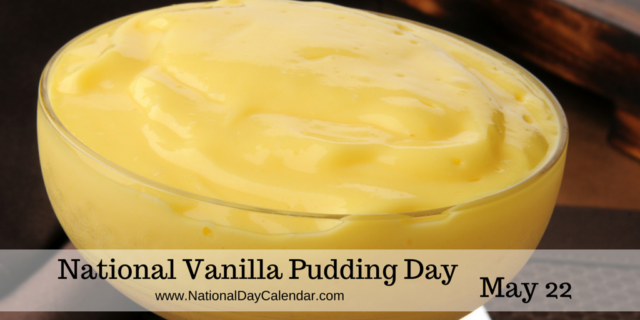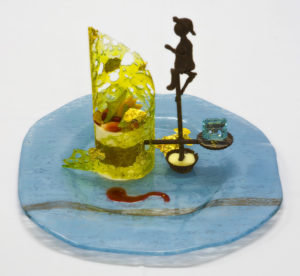
May 22nd is the day we recognize National Vanilla Pudding Day. Enjoy it with a delicious dish of cold, creamy vanilla pudding.
The puddings we enjoy as desserts today are not what was commonly known as pudding at ancient dinner tables. Most medieval puddings were meat based and seasoned with herbs and spices. Even sweetened, they were usually served hot. Toward the end of the 18th century, puddings were more likely made from a grains or day old bread with nuts, fruit or meats. These puddings were used to stretch meals for a large family.
The creamy pudding we are more familiar with today is related to the custard, minus the eggs.
Necessity may be the mother of invention, but spouses who are chemists are the inventor. When you are Alfred Bird and your wife is allergic to eggs, that is very true. In 1837, Bird invented an egg-free custard powder using flavored cornstarch.
The earliest packaged pudding in the United States was marketed by My-T-Fine in 1918. This and other puddings like them still required cooking on the stove. The instant version came along in the mid-1940s. On its own or as an ingredient in a larger recipe, pudding can be enjoyed in a variety of flavors.
- Hasty pudding, originally a British dish, this pudding could be made on very short notice. Ingredients vary, but it was basically a sweetened porridge made from flour, tapioca or oatmeal and milk. The term originated in the late 16th century.
- In Colonial America cornmeal was cheaper and more readily available, so here, Hasty Pudding was a cornmeal mush (cornmeal added to boiling water and cooked) with molasses, honey, brown sugar or maple syrup and milk.
- In the United Kingdom and some Commonwealth countries, pudding refers to rich, fairly homogeneous starch- or dairy-based desserts such as rice pudding and Christmas pudding, or, informally, any sweet dish after the main course.
- The sweet and creamy confection we know as pudding emerged in the mid-19th century when an English chemist named Alfred Bird developed an egg-free custard powder. This remarkable invention made it very easy to produce a delicious pudding with the perfect consistency.
- The word pudding is believed to come from the French boudin, originally from the Latin botellus, meaning “small sausage,” referring to encased meats used in Medieval European puddings.
- The proverb “The proof of the pudding’s in the eating” dates back to at least the 17th century.
- As part of a promotion, Healthy Choice was offering 500 frequent flyer miles to anyone who purchased 10 Healthy Choice products. David Philips recognized that if he purchased individual cups of pudding at 25 cents apiece he could easily rack up a lot of miles. He ended up with 1.25 million frequent-flyer miles for roughly $3,000. That’s the equivalent of 31 round trip tickets to Europe, or 42 tickets to Hawaii! He also donated the pudding cups to the Salvation Army and local food banks, and was able to write off the donations on his taxes.
- The Fortress hotel in Galle, Sri Lanka, is charging $14,500 a serving of the world’s most expensive pudding, which is called “The Fortress Stilt Fisherman Indulgence”.
(Image: The Fortress Resort and Spa) Arguably the world’s most expensive dessert, this delicately flavored treat is an Italian cassata, infused with Irish cream and seasonal fruit. A pomegranate and mango compote is added along with champagne sabayon (Dom Pérignon, of course), which form the base. It’s then decorated with Fortress’s handmade chocolate carving in the shape of a local fisherman clinging to his stilt (an ancient tradition still practiced in the region today), and gold leaf. Then a gorgeous aquamarine stone is added to the carving. It’s almost too beautiful to eat.
Sources:













